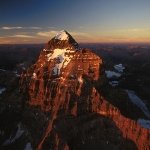Top of the World Provincial Park is a world-class alpine region in the Kootenay Range of the Rocky Mountains. Mount Morro is the highest peak in the park, towering at an incredible 2,912 metres. Many archaeological sites are located here, as the area was once the traditional territory of the Ktunaxa Nation. These early native people harvested chert, a grey, translucent, obsidian-like rock that was used to make tools and weapons.
Surrounding forests consists mainly of alpine fire and Engelmann spruce in the higher elevations, with lodgepole pine below 1,700m. In the lower reaches of the Summer Creek drainage and along Lussier River and Fish Lake, sitka alder is quite common. Near the timberline, alpine larch and white bark pine are interspersed with fir and spruce. Above 2,200m, alpine larch dominates. Much of the Top of the World plateau is covered with alpine wildflowers, including glacier lilies, mountain forget-me-nots and western anemones. At lower elevations, globeflowers, Indian paintbrush, broadleafed arnica, bunchberries and yellow columbines colour the landscape.
Small populations of large mammals inhabit the park including moose, elk white-tailed deer, wolverine and porcupine. Mule deer frequent the alpine meadows and marmots are found at higher elevations. Rocky Mountain bighorn sheep can be found in the vicinity of Mount Doolan and near Mount Morro, and mountains goats are seen on the ridges that form the western boundary of the park. An overabundance of birds lives around Fish Lake. During the summer, Clark’s nutcrackers, Steller’s jays, gray jays, thrushes and pine grosbeaks are quite common. Scaups, buffleheads, loons and other waterfowl inhabit the lake. During the spring when the fish spawn, bald eagles and ospreys can sometimes be seen soaring overhead.
The park offers opportunities for a variety of recreational activities year-round. The main draw to the area is wilderness hiking and camping. Fish Lake is noted for its cutthroat trout and dolly varden fishery, but you must have a valid British Columbia fishing licence and a copy of the park’s fishing regulations before casting a line. Horseback riding is permitted on the Fish Lake horse trail and on the Coyote Creek and Galbraith Creek trails. Mountain bike enthusiasts may only ride the 6-km hiking and horse trail between Nicol Creek trailhead parking lot and Fish Lake. And in the winter, snowshoeing and cross-country skiing is possible around Fish Lake and along Lussier River.
Backcountry wilderness camping is permitted in two main areas – Fish Lake and Coyote Creek. An overnight cabin that sleeps 20 people is available at Fish Lake on a first come, first serve basis, and there is 16 tent pad lakeside sites; 12 of these have fire pits. Coyote Creek camping area will accommodate 12 people. Water is scarce to non-existent in the plateau areas. Visitors are also reminded that this park is a rugged wilderness area with no supplies or equipment of any kind. Campers need to be fully self-sufficient and practice “no trace” camping.
Top of the World Provincial Park is located in the BC Rockies region of British Columbia, northeast of Kimberley and Cranbrook. You’ll find the access road to Top of the World Park on Hwy 93/95, just past Skookumchuk. Follow Sheep Creek Road. It’s very rough and not recommended for low-clearance vehicles. Alternatively, turn east off Highway 93/95, about 3 miles (4.5 km) south of Canal Flats, and travel southeast for about 32 miles (52 km) on the Whiteswan Forest Road. Both routes are well marked.
Nearby Regions & Towns
Park Notices


